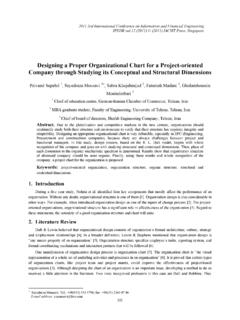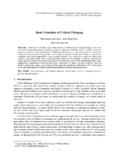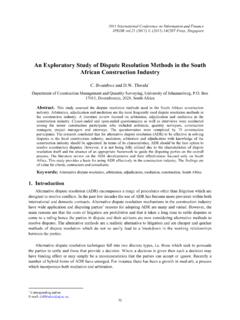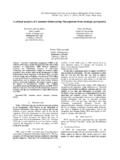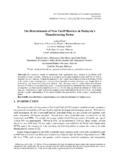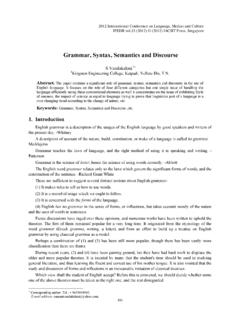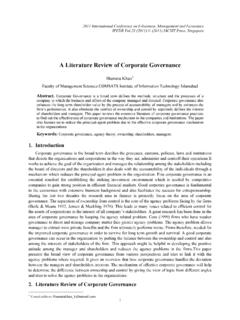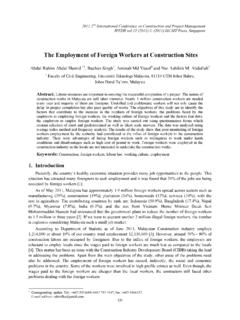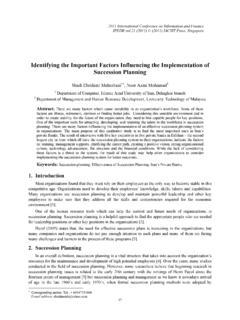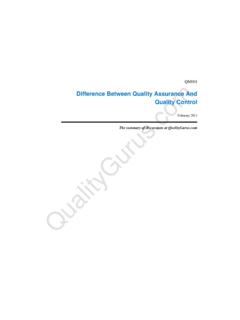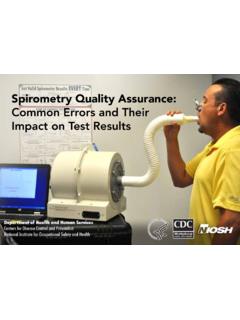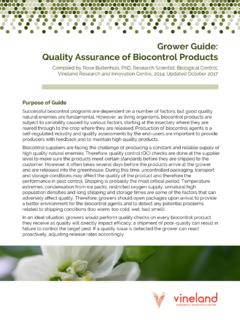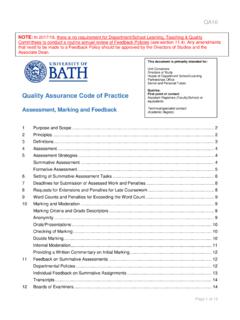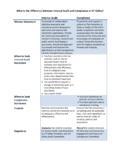Transcription of Service Quality and Customer Satisfaction in a ...
1 Service Quality and Customer Satisfaction in a Telecommunication Service Provider Siew-Phaik Loke1, Ayankunle Adegbite Taiwo2, Hanisah Mat Salim1, and Alan G. Downe2 1 Universiti Teknologi MARA (UiTM) Perak, Malaysia 2 Universiti Teknologi PETRONAS, Perak, Malaysia Abstract. Using the SERVQUAL model, this study aimed to examine the impacts of reliability, responsiveness, assurance , empathy and tangible aspects on Customer Satisfaction . A total of 200 current users of a GSM provider participated in this study. Gap analysis was used to determine the perceived importance and Satisfaction on each dimension of Service Quality , and regression analysis was conducted to test the relationship between Service Quality and levels of Customer Satisfaction . Results indicated that reliability, responsiveness, assurance and empathy significantly positively influenced Customer attitudes in terms of Satisfaction and loyalty.
2 In addition, t-test results showed that there was a significant gap between the perceived Satisfaction and importance (P-I) on all of the Service Quality dimensions. Keywords: Service Quality , Customer Satisfaction , telecommunication, Malaysia 1. Introduction Telecommunication Service providers (TSPs) are of paramount importance to both developed and emerging economies In Malaysia, TSPs are projected to contribute greatly to the national goal of achieving status as a developed nation by the year 2020. With stiff competition between three providers of Global System for Mobile Communications (GSM) and one private automatic branch exchange (PABX) landline provider, Customer Satisfaction is a necessity for survival in the market. At the same time, Malaysians are becoming equipped with necessary knowledge about Quality Service delivery. Many telecommunication Service providers in Malaysia offer various products and services in the market.
3 TSPs have to compete with each other to ensure optimal Customer Satisfaction in terms of products or services . Quality is generally regarded as being a key factor in the creation of worth and in influencing Customer Satisfaction . Hence, the telecommunication industry in Malaysia has to be strategically positioned to provide Quality services to satisfy customers. To provide improved Quality Service , telecommunication companies need to investigate degree of customers sensitivity and expectations toward Service Quality . Armed with such information, telecommunication outfits are then able to strategically focus Service Quality objectives and procedures to fit the Malaysian market. The purpose of this study was to examine the impact of several product and Service delivery factors on reported levels of Service Quality within a single GSM provider. 2. Literature Review Importance of Service Quality Service Quality can be described as a rationale of differences between expectation and competence along the important Quality dimensions.
4 Parasuraman, Zeithaml and Berry [1] identified ten requirements useful for customers evaluation of the Quality of services : reliability, responsiveness, tangibles, communication, credibility, security, competence, courtesy, understanding the customers and Service accessibility. Zeithaml, Parasuraman, and Berry [2] proposed a Service Quality scale (SERVQUAL), a generic instrument that has 5 242011 International Conference on Financial Management and Economics IPEDR (2011) (2011)IACSIT Press, Singapore dimensions of Service Quality : reliability, responsiveness, assurance , empathy and tangibles, the constructs were found to have high correlation. This instrument continues to be widely used in marketing studies of Customer Satisfaction and consumer preference [3], despite some argument that other models may be better [4] [5] [6] and [7]. The stage of performance that a top Quality Service will need to give was conditioned through the expectation of the customers.
5 Service Quality is judged low when the performance was below expectation. The SERVQUAL model is a common diagnostic tool used to measure Customer Service and perceived Satisfaction . Reliability is the Service company ability to deliver promises on time. In this study we focused on five factors that could predict the Quality of the Service provided by the investigated telecommunication Service provider. Responsiveness is the degree to which customers perceive Service providers readiness to assist them promptly. assurance is the degree of courtesy of Service providers workers and their ability to communicate trust to customers. Empathy is the care and importance the Service provider gives to an individual Customer , and the degree to which specific Customer needs and preferences can be understood and articulated. Lastly, tangibility is the evidence of facilities, personnel, and communication materials used by the company while offering services to customers [2] [8].
6 Service Quality Gap In previous Service research, meeting and exceeding expectations of clients and customers is a perspective that has gained most attraction. This concept is all inclusive and cuts across Service domains, but expectations change and experiences with alternate Service providers could shape the customers expectations. The important research gap here is attaining customers expectation towards a particular Service [8]. A gap is the difference, imbalance or disparity which is determined to exist between customers perception of firm performance and their prior Service Quality (SQ) perceived by customers is therefore as a result of a comparison of customers expectation (E) of services that the organization should offer versus their perception of the performance (P) delivered by the Service organization. Management of Service Quality largely focuses on managing the gaps between expectations and perceptions of customers [9].
7 The goal of the firm is to minimize the gap between (P) and (E). Rowley [10] pointed out that previous researchers such as Lehtinen and Lehtinen [11] and Gronroos [12] also applied gap principles similar to that proposed by Parasuraman et al. [1]. Customer Satisfaction Customer Satisfaction is a personal feeling of either pleasure or disappointment resulting from the evaluation of services provided by an organization to an individual in relation to expectations [13] [14]. Service providers frequently place a higher priority on Customer Satisfaction , because it has been seen as a prerequisite to Customer retention. As a positive outcome of marketing activities, high Customer Satisfaction leads to repeat visitation to stores, repeat product purchases, and word-of-mouth promotion to friends [15] [17], while low Customer Satisfaction has been associated with complaining behavior [19].
8 A satisfied Customer often stays loyal longer, and is likely to patronise the firm in future [3]. Customer Satisfaction can be conceptualized as either transaction-specific Satisfaction or cumulative Satisfaction [20]. Transaction-specific Satisfaction is a Customer s evaluation of her or his experience and reactions to a specific company encounter [21]. Cumulative Satisfaction refers to customers overall evaluation of patronage experience from inception to date [22]. 3. Methodology Research Model and Hypotheses The aims of this study are twofold: First, using SERVQUAL model, we examined significant differences in the five Service Quality dimensions (tangibility/physical aspects, reliability, responsiveness, assurance and empathy) by evaluating customers expectations and their actual perceptions of the GSM telecommunication Service Quality (SQ) = Customer s Perception (P) Customer s Expectations (E) 25firm.
9 Secondly, we examined the impact of the five Service Quality dimensions on Customer perceptions of Service delivered by the firm (see Fig. 1). Fig. 1: Research Framework The five hypotheses are as follows: H1: Tangibility will have a significant impact on Customer Satisfaction H2: Reliability will have a significant impact on Customer Satisfaction H3: Responsiveness will have a significant impact on Customer Satisfaction H4: assurance will have a significant impact on Customer Satisfaction H5: Empathy will have a significant impact on Customer Satisfaction 4. Data Analysis and Results Demographic Profile Participants of this study were 119 female and 81 male consumers. Mean age was (SD= ). 20 were students whereas 180 of them are working adults percent private sector jobs, 31 percent were government servants, and percent were self-employed. In term of ethnicity background, the majority of participants were Malay ( percent), followed by Chinese ( percent) and Indian participants (or 21 percent).
10 Reliability Cronbach s alpha reliability analysis was conducted on the independent variables in order to determine the reliability of the instrument used. Nunnally [23] has suggested as the acceptable level for reliability measure. Alpha values ranged from to , thus indicating an acceptable level of reliability (see Table 1). Table 1: Reliability Analysis Service Quality Dimensions Cronbach s Alpha Expectations PerceptionsTangibility/ Physical aspects Customer Service counter is well-equipped with up-to-date facilities reload/top-up machine, free WIFI. Physical layout of equipment and furniture are comfortable for Customer interacting with staff. Staff are well-dressed and appear neat. Material and information associated with the Service ( promotional brochure) are visually appealing at the Customer Service counter. Reliability When the Service provider promises to do something by a certain time, services 26are delivered as promised.
